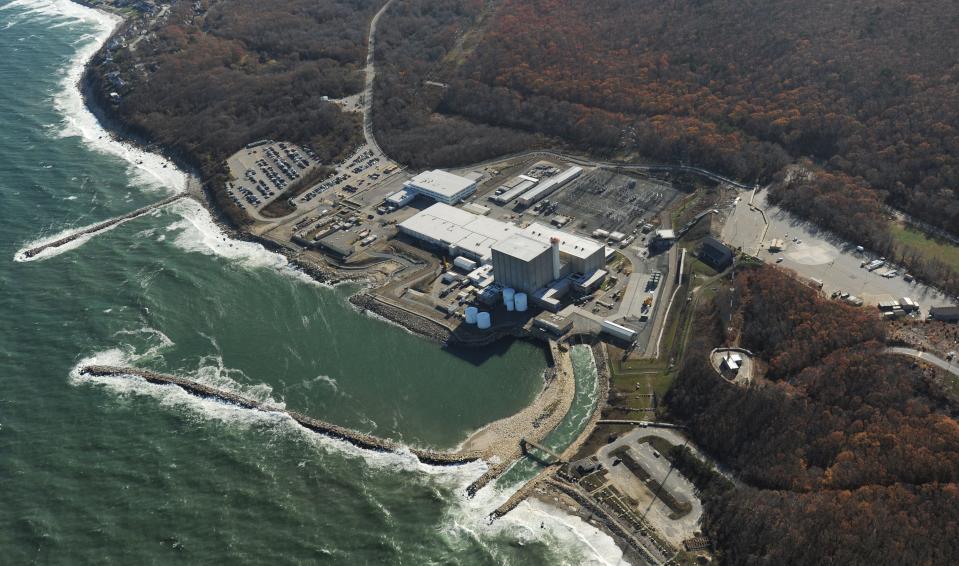Radioactive water from Pilgrim plant to be dumped into Cape Cod Bay
PLYMOUTH – The company decommissioning Pilgrim Nuclear Power Station has told the Nuclear Regulatory Commission that it plans to start discharging radioactive water from the plant into Cape Cod Bay within the first three months of 2022.
U.S. Rep. William Keating, D-Mass., shared an email with the Cape Cod Times that his staff received from the the commission Wednesday that confirmed Holtec International had informed the agency of its plan to release radioactive water into the bay.
A week earlier, Holtec spokesman Patrick O'Brien told a Nuclear Decommissioning Citizens Advisory Panel in Plymouth there were other options, including evaporating the million gallons of water from the spent fuel pool and the reactor vessel and other plant components or trucking it to a facility in Idaho.
Previously: Pilgrim nuclear plant may release 1M gallons of radioactive water into bay. What we know

Keating said that not disclosing their plans at a public forum violated promises of transparency.
"It's troubling that within a couple of days it turned into a sure thing," Keating said Friday.
"If Holtec had true concern for public health and the environment and worked with transparency as they promised, Holtec would halt any dumping until a viable solution is found acceptable," said Diane Turco, director of Cape Downwinders, a citizen watchdog group. "(D)umping into Cape Cod Bay just highlights the fact that the NRC and Holtec don’t have a solution for what to do with nuclear waste. Contaminating our environment is part of the nuclear nightmare process and that is immoral."
Of more concern to Keating than the lack of transparency was what he said was a decision motivated by cost and not by necessity.
Two years ago, during the negotiations for longtime plant owner Entergy Nuclear Operations to sell Pilgrim to Holtec for the purposes of decommissioning, Keating said he and others expressed concern about turning the process over — including the $1.03 billion decommissioning trust fund — to a private company that hadn't yet dismantled a nuclear plant. At the time, state Attorney General Maura Healey tried to intervene on that basis, citing concerns that the billion-dollar fund might prove insufficient and that Pilgrim would be Holtec's first shot at decommissioning.
In interviews, both the Nuclear Regulatory Commission and Holtec said that discharging radioactive water into the ocean is a common practice in the nuclear industry and is the least expensive method. O'Brien said Pilgrim discharged radioactive water into Cape Cod Bay as recently as 2017.
Keating said there is also a profit motive to the dumping plan.
"They are responsible to their shareholders, and that's what is going to drive them," he said.
In an interview, Harold Anagnostopoulos, Nuclear Regulatory Commission plant inspector and senior health physicist for Region 1 (which includes New England) said the water from the plant cannot be discharged unless it meets standards for radioactivity materials and levels. The water is handled in batches (Holtec said the batches will be 20,000 gallons) and is cycled through filters to remove metals and other possible contaminants as well as any longer-lived high radioactive elements.
Radioactive tritium is generally what is released from nuclear power plants and the Department of Energy website put its half-life at 12.3 years.
Anagnostopoulos said the level of radiation allowed to be discharged is 100 millirems. To put that in perspective, soil contains roughly 21 millirems and a mammogram exposes the patient to 42 millirems, according to U.S. Department of Energy data. A cardiac CT scan contains over 2,000 millirems.
Anagnostopoulos said the 100-millirem level is right at the mouth of the outfall before dilution comes into play. He said sensors at the mouth of the discharge pipe and at a distance measure radiation, and plant employees do biological and water sampling and submit them to an independent lab to test for bioaccumulation. He said there are also risks in transporting radioactive water, such as the potential for a crash or spill along the route, and that it is transferring a problem elsewhere.
But Keating said claims of low radiation levels in nuclear plant effluent were only one part of the decision-making process. He said the potential biological and economic damage caused to maritime industries such as fisheries, aquaculture and recreation, including the public perception that they may be tainted with radioactivity, should have been factored in. If it was, he said, the clear choice was to truck the water to another site, not dump it into the ocean.
"The issue is much more clear-cut. We have an alternative (trucking) and the only difference is cost," said Keating, who argued that the $1 billion in the trust fund came from ratepayers and that they deserved the best disposal solution that preserved their environment and maritime industries.
Contact Doug Fraser at dfraser@capecodonline.com. Follow him on Twitter: @dougfrasercct.
This article originally appeared on Cape Cod Times: Holtec to dump radioactive water from nuclear plant into Cape Cod Bay

